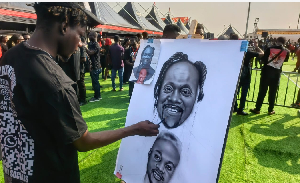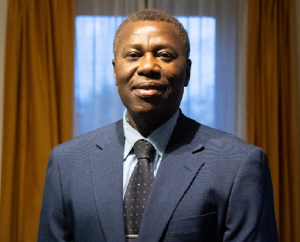Road accidents claim many lives, leave great numbers of people injured, traumatised and costs Ghana billions of cedis every year.
In 2019, Ghana recorded 2,284 deaths on the road, 1,555 being men and 380 being women.
In the same year, a total of 14,397 got various degrees of injuries through road carnage which is quite more than the 13,677 recorded in 2018.
This is an indication that many more Ghanaians including children who got injured through accidents are presently going through trauma because they have been left with temporary or permanent disability from the injuries.
Head of Trauma and Orthopaedics at the Komfo Anokye Teaching Hospital (KATH), Dr Dominic Konadu-Yeboah, recently was reported to have disclosed that Ghana loses about US$230 million annually through trauma cases resulting mostly from road accidents.
Road traffic trauma accounts for significant rate of all accidents in Ghana with the most common cause of death after trauma among patients being injury to the brain and the spinal cord, excessive bleeding and delays in getting patients to hospital.
The Okada trend
A worrying trend is the emergence of motorcycles or tricycles popularly called “okada”, “aboboyaa” or “pragya”, depending on their mould which have become integral part of the commercial transport environment.
This mode of transport has come to add on to the accident situation in the country and increased number of victims and trauma cases.
Operations of motorbikes have become indispensable due to the extremely poor nature of roads that make movement of four-wheel vehicles difficult in most parts of Ghana.
They have also become indispensable due to the heavy traffic in the urban areas.
As a result, people in most communities rely on commercial motorbikes for all their socio-economic activities including farming, funerals, going to the market, offices and other social gatherings.
Recently, Assembly Members were supplied motorbikes to facilitate their mobility to assembly sessions and deprived communities to enhance local governance.
Reports gathered so far indicate that some of these Assembly Members have converted theirs into commercial motorbikes to generate income for themselves.
Meanwhile, as we speak, L.I. 2180 prohibits the use of motorbikes and tricycles for commercial operations in Ghana.
Apart from facilitating the movement of goods and people from one place to another, motorbikes are also a form of income-generation tool for people in the low-income bracket.
For instance, “aboboyaa” is useful in the carting of farm inputs to farm as well as carting produce from the farm to homes and market centers.
Hitherto, most perishable farm produce got rotten on the farm due to transportation challenges as these farms are characterised with bushy paths and non-motorable roads, making the use of motorbikes crucial as they can traverse the rough terrains.
Aboboyaa is also used to distribute products to various stores in urban centres.
Apart from being used for funeral processions including the carriage of mourners and corpses from one village to another, motorbikes also serve as ambulances for pregnant women in labour and accident victims.
In fact, motorbikes and tricycles are used for commercial purposes - though illegally - in the glare of enforcement agencies for income generation ventures in small and big towns or cities.
Elsewhere, Metropolitan, Municipal and District Assemblies (MMDAs) rely on the pragya, okada and the aboboya to boost their Internally Generated Funds (IGF) since they pay taxes or tolls.
Last year in Koforidua, a new mother who had been discharged from delivery room from the Eastern Regional Hospital in Koforidua lost her baby a few minutes after being discharged. The woman instead of boarding a taxi or a safer vehicle, went to board a pragya (tricycle) with intention to reduce transport cost.
Consequently, her baby slipped off her hands and fell on the ground. The day old baby died.
I kept asking myself; what if the baby did not die but severely got injured (in the brain or on its limbs)?
You can imagine the trauma this woman would have subjected her baby to from that age till its adulthood.
According to the Buildings and Roads Research Institute (BRRI) Report for 2018, motorcycle users in road traffic deaths have consistently been on the rise lately.
The Report indicated that nationally, motorcycle or okada crashes account for 27.7 percent of all road crashes in Ghana.
That is, a total of 4,399 crashes. Of the number, 3,474 persons got injured while 732 persons died.
The Eastern Regional Manager of the National Road Safety Authority (NRSA), Mr. Abdulai Bawa Ghamsah, recently expressed worry that the bad attitude of road users has been the bane of road accident fight in Ghana.
Okada, pragya or aboboyaa riders are making this effort even worse.
However, one thing can be clear; No matter who is at fault, or whose priority it may have been, road crashes cause injury, misery and a lot of inconveniences to individuals, families and the nation as a whole.
The need for all hands to be on deck to prevent injuries resulting from road crashes.
Traditional healers
One other key challenge in reducing accident related trauma has been the rate at which many with fractures resort to care from traditional healers thus increasing complications.
Disturbingly, these persons would usually eventually end up in the hospital with worsened situation such as developing dead limbs calling for amputation to stay alive.
Sustainable Development Goal (SDG) three implores nations to work at reducing road traffic injuries and deaths by the end of 2020.
It has become so necessary for Ghana to be extra alert on the carnages on its roads, especially the upsurge of motorbikes related crashes.
It is therefore in the right direction that the mandate of the NRSA has been beefed up and now given the power to bite in its new ACT (Act 993).
Preventing injuries
One William Haddon in 1970 developed a matrix to look at factors related to personal attributes, vector or agent attributes and environmental attributes; before, during and after an injury or death.
By that matrix, he suggested that before any crash (on the road), more information (in the form of education or sensitization) should be more.
It can be door-to-door, via the media (radio/TV, print etc). The information should seek to correct the attitudes of road users and enforcement must be executed to the letter.
For instance, the NRSA, the MMDAs and the DVLA can collaborate to hit the road to gather okada riders and drivers in the various MMDAs, train them and provide them with the requisite licenses to operate responsibly.
Assembly members can also be trained to sensitise their electorates or pedestrians on being alert on the road.
The Haddon Matrix also suggested that vehicles’ road worthiness should be paramount considering their speed management.
It also indicated that road designs, speed limits and pedestrian facilities must be adequately provided to guide all road users including the okadas.
The Matrix as well indicated that even when the crash has occurred, there should be crash-protective roadside objects to reduce the crash severity.
Also, handlers must possess some first aid skills (maybe this should be imbedded in educational curriculum from basic school to tertiary level),rescue facilities and medics should be readily and easily accessible.
This will reduce severity of injuries which can end up in trauma.
Perhaps another solution will be for political parties to fuse in paediatric care policies into their manifestos before they are voted for and to ensure that when they climb the governance seat they implement those policies to the core.
Maybe, this year (2020) being an election year, Ghanaians must resolve that the political party that will omit accident and injury prevention roadmap in their manifestos should not be voted for.
No more accident-related trauma cases!
Opinions of Friday, 28 February 2020
Columnist: McAnthony Dagyenga, Contributor















